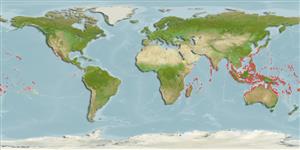Common names from other countries
Environment: milieu / climate zone / depth range / distribution range
Ecologie
Rifbewoner; diepteverspreiding 0 - 30 m (Ref. 96667). Tropical
Indo-Pacific: Cocos Islands to French Polynesia and Hawaii.
Length at first maturity / Size / Gewicht / Leeftijd
Maturity: Lm ? range ? - ? cm Max length : 18.0 cm CW mannelijk/geslacht niet bekend; (Ref. 343)
Carapace ovate; dorsal surface very smooth and convex. Color: cream to pink ground color, with 9 large violet to maroon spots on dorsal surface of carapace: 3 on median region, 2 on posterior region, 2 on anterolateral region, and 2 around orbits.
Maximum depth from Ref. 122032. Collected extensively for food (Ref. 343). Marginal levels of toxicity were detected in this species which may contribute to human poisoning (Ref. 107779). Inhabits reefs. Benthic (Ref. 343). Subtidal (Ref. 106854). Subtropical and tropical climates (Ref. 343). Nocturnal. Crushes other crustaceans and snails (Ref. 122680). Feeds on marine snails (Ref. 85383).
Life cycle and mating behavior
Geslachtsrijpheid | Voortplanting | Kuitschieten | Eieren | Fecundity | Larven
Members of the order Decapoda are mostly gonochoric. Mating behavior: Precopulatory courtship ritual is common (through olfactory and tactile cues); usually indirect sperm transfer.
Ng, P.K.L. 1998. (Ref. 343)
Status op de Rode Lijst van het IUCN (Ref. 130435)
Status bij CITES (Ref. 108899)
Not Evaluated
Not Evaluated
Gevaarlijk voor mensen
Poisonous to eat (Ref. 107779)
Gebruik door de mens
Visserij: commercieel
| FishSource | Sea Around Us
Tools
Meer informatie
Leeftijd/GrootteGroeiLengte-gewicht parametersLengte-lengte parametersMorfologieLarvenAbundantie
Internet-bronnen
Estimates based on models
Preferred temperature
(Ref.
115969): 24.4 - 29.3, mean 28.4 (based on 3402 cells).
Kwetsbaarheid
Low vulnerability (10 of 100).
Prijsklasse
Unknown.
